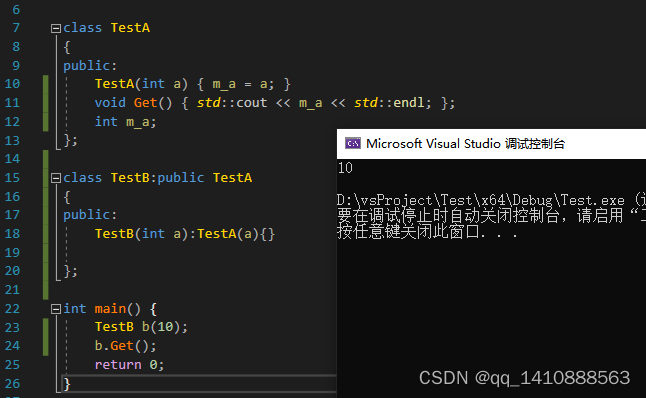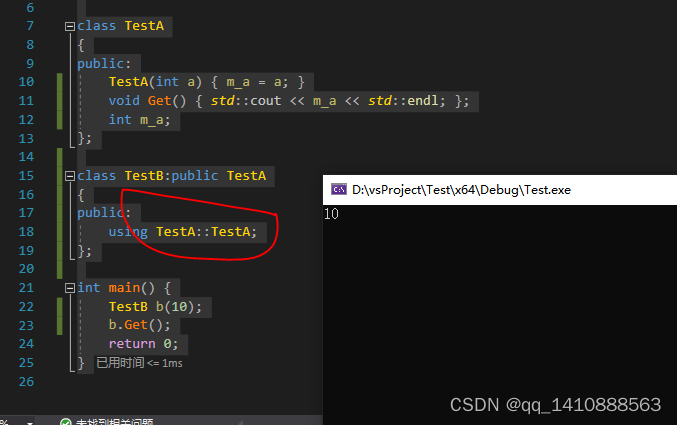C++11 委派构造用法
发布时间:2023年12月20日
重点:
1.委派构造优势在于
(1)如果继承它的子类构造不需要参数,则它直接继承基类的构造,节省代码空间。
(2)如果没有代码使用基类的构造函数,它不就会产生多余的代码。
缺点:
如果继承的基类的构造函数有自身的参数,这就不太适用。
初始代码:
class TestA
{
public:
TestA(int a) { m_a = a; }
void Get() { std::cout << m_a << std::endl; };
int m_a;
};
class TestB:public TestA
{
public:
TestB(int a):TestA(a){}
};
int main() {
TestB b(10);
b.Get();
return 0;
}

委派构造:
class TestA
{
public:
TestA(int a) { m_a = a; }
void Get() { std::cout << m_a << std::endl; };
int m_a;
};
class TestB:public TestA
{
public:
using TestA::TestA;
};
int main() {
TestB b(10);
b.Get();
return 0;
}

文章来源:https://blog.csdn.net/qq_38409301/article/details/135104599
本文来自互联网用户投稿,该文观点仅代表作者本人,不代表本站立场。本站仅提供信息存储空间服务,不拥有所有权,不承担相关法律责任。 如若内容造成侵权/违法违规/事实不符,请联系我的编程经验分享网邮箱:chenni525@qq.com进行投诉反馈,一经查实,立即删除!
本文来自互联网用户投稿,该文观点仅代表作者本人,不代表本站立场。本站仅提供信息存储空间服务,不拥有所有权,不承担相关法律责任。 如若内容造成侵权/违法违规/事实不符,请联系我的编程经验分享网邮箱:chenni525@qq.com进行投诉反馈,一经查实,立即删除!
最新文章
- Python教程
- 深入理解 MySQL 中的 HAVING 关键字和聚合函数
- Qt之QChar编码(1)
- MyBatis入门基础篇
- 用Python脚本实现FFmpeg批量转换
- idea使用ssh连接docker,并通过Dockerfile文件,直接在idea中启动docker应用,并进行远程debug
- ELK之集群安全认证设置
- JOSEF约瑟LB-8断相闭锁继电器 额定电压 100V 额定频率 50Hz 面板嵌入式安装
- 100天精通风控建模(原理+Python实现)——第12天:风控建模中的相关系数分析是什么?怎么实现?
- windows系统如何查看扇区?
- vue3+vite 项目常用库
- Halcon基于相关性的模板匹配
- 连获4大奖项,欧科云链成Web3行业领跑者
- 网络安全B模块(笔记详解)- MYSQL信息收集
- 红日靶场之sta&&ck远程桌面控制 个人学习)